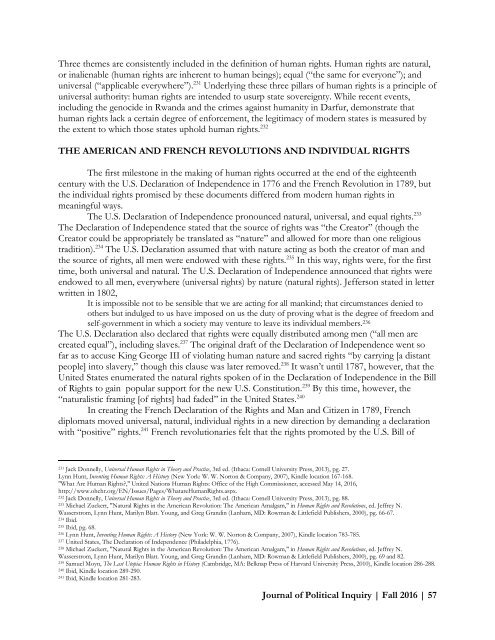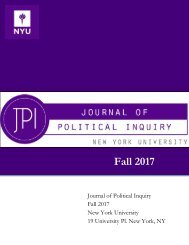Fall2016_Final2
You also want an ePaper? Increase the reach of your titles
YUMPU automatically turns print PDFs into web optimized ePapers that Google loves.
Three themes are consistently included in the definition of human rights. Human rights are natural,<br />
or inalienable (human rights are inherent to human beings); equal (“the same for everyone”); and<br />
universal (“applicable everywhere”). 231 Underlying these three pillars of human rights is a principle of<br />
universal authority: human rights are intended to usurp state sovereignty. While recent events,<br />
including the genocide in Rwanda and the crimes against humanity in Darfur, demonstrate that<br />
human rights lack a certain degree of enforcement, the legitimacy of modern states is measured by<br />
the extent to which those states uphold human rights. 232<br />
THE AMERICAN AND FRENCH REVOLUTIONS AND INDIVIDUAL RIGHTS<br />
The first milestone in the making of human rights occurred at the end of the eighteenth<br />
century with the U.S. Declaration of Independence in 1776 and the French Revolution in 1789, but<br />
the individual rights promised by these documents differed from modern human rights in<br />
meaningful ways.<br />
The U.S. Declaration of Independence pronounced natural, universal, and equal rights. 233<br />
The Declaration of Independence stated that the source of rights was “the Creator” (though the<br />
Creator could be appropriately be translated as “nature” and allowed for more than one religious<br />
tradition). 234 The U.S. Declaration assumed that with nature acting as both the creator of man and<br />
the source of rights, all men were endowed with these rights. 235 In this way, rights were, for the first<br />
time, both universal and natural. The U.S. Declaration of Independence announced that rights were<br />
endowed to all men, everywhere (universal rights) by nature (natural rights). Jefferson stated in letter<br />
written in 1802,<br />
It is impossible not to be sensible that we are acting for all mankind; that circumstances denied to<br />
others but indulged to us have imposed on us the duty of proving what is the degree of freedom and<br />
self-government in which a society may venture to leave its individual members. 236<br />
The U.S. Declaration also declared that rights were equally distributed among men (“all men are<br />
created equal”), including slaves. 237 The original draft of the Declaration of Independence went so<br />
far as to accuse King George III of violating human nature and sacred rights “by carrying [a distant<br />
people] into slavery,” though this clause was later removed. 238 It wasn’t until 1787, however, that the<br />
United States enumerated the natural rights spoken of in the Declaration of Independence in the Bill<br />
of Rights to gain popular support for the new U.S. Constitution. 239 By this time, however, the<br />
“naturalistic framing [of rights] had faded” in the United States. 240<br />
In creating the French Declaration of the Rights and Man and Citizen in 1789, French<br />
diplomats moved universal, natural, individual rights in a new direction by demanding a declaration<br />
with “positive” rights. 241 French revolutionaries felt that the rights promoted by the U.S. Bill of<br />
231<br />
Jack Donnelly, Universal Human Rights in Theory and Practice, 3rd ed. (Ithaca: Cornell University Press, 2013), pg. 27.<br />
Lynn Hunt, Inventing Human Rights: A History (New York: W. W. Norton & Company, 2007), Kindle location 167-168.<br />
"What Are Human Rights?," United Nations Human Rights: Office of the High Commissioner, accessed May 14, 2016,<br />
http://www.ohchr.org/EN/Issues/Pages/WhatareHumanRights.aspx.<br />
232<br />
Jack Donnelly, Universal Human Rights in Theory and Practice, 3rd ed. (Ithaca: Cornell University Press, 2013), pg. 88.<br />
233<br />
Michael Zuckert, "Natural Rights in the American Revolution: The American Amalgam," in Human Rights and Revolutions, ed. Jeffrey N.<br />
Wasserstrom, Lynn Hunt, Marilyn Blatt. Young, and Greg Grandin (Lanham, MD: Rowman & Littlefield Publishers, 2000), pg. 66-67.<br />
234<br />
Ibid.<br />
235<br />
Ibid, pg. 68.<br />
236<br />
Lynn Hunt, Inventing Human Rights: A History (New York: W. W. Norton & Company, 2007), Kindle location 783-785.<br />
237<br />
United States, The Declaration of Independence (Philadelphia, 1776).<br />
238<br />
Michael Zuckert, "Natural Rights in the American Revolution: The American Amalgam," in Human Rights and Revolutions, ed. Jeffrey N.<br />
Wasserstrom, Lynn Hunt, Marilyn Blatt. Young, and Greg Grandin (Lanham, MD: Rowman & Littlefield Publishers, 2000), pg. 69 and 82.<br />
239<br />
Samuel Moyn, The Last Utopia: Human Rights in History (Cambridge, MA: Belknap Press of Harvard University Press, 2010), Kindle location 286-288.<br />
240<br />
Ibid, Kindle location 289-290.<br />
241<br />
Ibid, Kindle location 281-283.<br />
Journal of Political Inquiry | Fall 2016 | 57
















